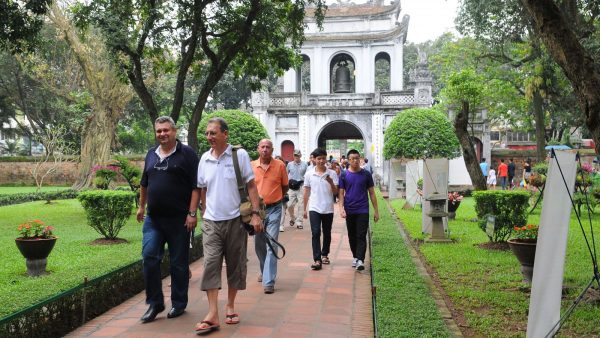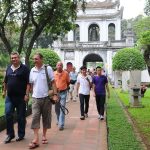Hanoi is a famous tourist attraction with various special cultural heritage sites. By specific and effective solutions, the city’s tourism authorities have created a great deal among the people and visitors about civilized behaviors at places of worship and cultural relics.

Temple of Literature.
Hanoi is a proud city of thousands of historical and cultural relics: the Old Quarter of Hoan Kiem District; the area around West Lake; the area of Co Loa relic site, Hai Ba Trung temple, and Soc mountain; Dong Quan lake; the area of Huong pagoda, Huong Son landscape, and Quan Son lake, Tuy Lai; the area of Ba Vi, Duong Lam ancient village, Thay pagoda, and Huong pagoda; Bat Trang pottery village; Van Phuc silk village; Ha Thai lacquer village (Thuong Tin) and the area for community tourism (homestay); tourism tours connecting traditional craft streets with traditional villages and some typical villages in the area.
Hanoi’s tourism is aiming at maintaining a “safe, friendly, quality, and attractive” tourism environment, establishing Hanoi as one of the major tourist centers in the region. The most important task among others is to build a culture of tourism, the golden key to sustainably developed tourism of the capital city. In this spirit, the planning for Hanoi’s tourism development to 2020, vision to 2030 has identified cultural tourism as a strength and distinct feature of the capital city. In order for cultural heritage to have a place in tourism development, Hanoi is changing its behavior towards cultural heritage sites and places of worship with an aim to contribute to a civilized lifestyle in the community. Offensive and repugnant gestures at cultural relics, such as showing up in revealing clothes, littering, scribbling on architectural works, and other misbehaviors are regarded as long-standing stigma of cultural behavior, the elimination of which requires joint efforts of the community and is expected to help Hanoi find its way back to the intrinsic values of cultural heritage of this thousand-year-old land.
Since the pilot launch of the walking space around Hoan Kiem Lake and surrounding areas on weekends, Hanoians and visitors have gotten not only more space for strolling and enjoyment, but also more cultural heritage sites and places of worship to visit. The walking space around Hoan Kiem Lake and surrounding areas has confirmed its effectiveness and appeal to the community and visitors and has been able to promote the cultural and historical values of ancient spaces as well as stimulate tourism development.
Another popular tourist attraction is Ngoc Son Temple. In ensuring civilized behaviors of visitors, since the beginning of April this year, the Ngoc Son Temple Management Board has launched a program that lends free jackets to visitors who may wear inappropriate clothes. The jackets are of variant sizes and styles suitable for men and women. Visitors are to be guided with care to avoid them getting shy away from visiting the temple. This program will also be deployed in many other popular relic sites such as Phu Tay Ho (West Lake Pagoda) and Van Mieu – Quoc Tu Giam (Temple of Literature). In many places, the diversification of propaganda will gradually help people and visitors to behave civilly.

Duong Lam ancient village
Mong Phu Communal House (Duong Lam, Son Tay, Hanoi) welcomes a daily number of hundreds of visitors. For visitors to behave civilly when entering the House, the local people first have to set an example by ensuring that anyone, regardless of age, that may enter the House must hold a serious expression and offer respectful behaviors. The behaviors of the local people will spread to visitors and help honor the cultural heritage of their homeland.
As mentioned above, Hanoi is changing its behavior towards cultural heritage sites and places of worship in order for cultural heritage to have a place in tourism development. Introducing the unique values Hanoi’s traditional heritage sites is a step to preserving and promoting the stature of the capital city known for its thousand-year-old civilization. Another approach is to form civilized behaviors in the community and visitors when entering sacred cultural relic sites.
Hong Linh

